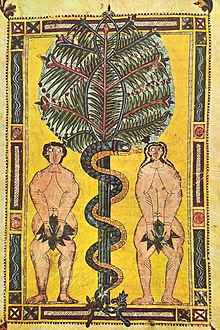Parchment
The parchment (from the late Latin pergamīnum, and this from the Byzantine Greek pergamēnḗ; literally 'from Pergamum', because in this city the skins were prepared for writing) is a material made from the lambskin or other animal skin, specially made to be able to write on it. The skin follows a process of removing the epidermis and hypodermis, leaving only the dermis, and stretching, at the end of which the leaves are obtained with which a book, a phylactery or the scrolls that were known from the Antiquity.
The origin of its name is the city of Pergamum, where it is believed that there was a high-quality production, although its existence really dates back to a time before the city of Pergamum. At present it is considered that between Among the oldest surviving parchment manuscripts is the Isaiah Scroll or 1Qlsa (also called the Great Isaiah Scroll), dated between 150 and 100 B.C. c.
History
Since ancient times this material was used to write literary and sacred texts. Prior to parchment, papyrus was used, which was a more fragile and uncomfortable material for both the copyist and the reader. The parchment ended up replacing the papyrus due to its material advantages, as it is an easier support to obtain than papyrus, much more durable and of better quality. Pergamum became the producing city par excellence, giving its name to this material. The volumes of the Pergamum Library began to be copied on parchment, replacing papyrus. A legend with no historical foundation tells that this change was due to the fact that the city of Alexandria, a rival to the city of Pergamum in terms of building libraries and producing texts, stopped supplying Eumenes with papyrus material, material whose distribution had monopolized, but the truth is that parchment had already been used in Egypt since the ii millennium BC. C., in addition to the fact that papyrus was also cultivated in these regions of Asia.
Ancient Rome
Papyrus and parchment coexisted for many years. Books made by Roman workshops, as well as archival documents and letters, continued to be copied on papyrus rolls, while parchment was reserved for works of a subordinate nature or small literary compositions, as Marcial recounts in his Epigrams. The parchment began to be used to copy well-made books when the new codex or codex format spread from the fourth century AD.
Although the form of the book called the codex was known from the first century, it did not spread until the fourth century. The codices were composed of folded, sewn, and bound parchment notebooks imitating the formal appearance of the polyptychs of waxed tablets that were also written on in Antiquity. The name codex itself comes from the way in which such tablets were identified (codex) and the first codices were known as codex membranei. Despite everything, a parchment industry was born in Rome right away, giving rise to shops called membranii shops.
One of the advantages that parchment had over papyrus was that it could be written on on both sides of the skin, it could also be scraped off or washed and reused; Even so, their high cost meant that they did not replace the use of papyrus rolls for quite some time.
Among the Romans, at the beginning of the 2nd century, parchment was already in common use and it was in the period of the Late Empire when it definitively displaced the papyrus that still existed, since it was much cheaper and easier to obtain. In reality, the Romans did not stop using papyrus after the inclusion of parchment, especially for writings that they considered less important, such as letters, some documents, etc.
Parchment manufacturing process
The parchment used to make books and documents was made from the skins of young animals (lamb, calf or kid) because the adult individuals provided a strong and coarse membrane that made it difficult to sew the notebooks. Of the three parts that make up a skin, the parchment is made only with the dermis, it had to eliminate the epidermis and the hiccups so that only the dermis remained during the manufacturing process. To facilitate their separation, the skins are submerged in a lime solution that will allow peeling and fleshing. They are then stretched on an easel to be stretched and finished, while the resulting surface is rubbed with the help of a pumice stone to remove the last impurities and polish the writing surface. The highest quality parchment was vellum, made from the skins of unborn or newborn animals that was reserved for the most luxurious codices. On the other hand, the coarser parchment is usually used to make drums, tambourines or the like.
There is a fake parchment manufactured today called 'parchment paper', which is used among other things to make lampshades and crafts. It is made from ordinary paper, submerged in a solution of two parts of concentrated sulfuric acid to one part of water. After a few seconds in this solution the acid is neutralized. It is used in tourist places such as restaurants.
The parchment in bullfighting
Parchment was used in bullfighting in the 17th century century. During the fight with the bull, pieces of parchment called patches were used. These patches could be colored and were smeared with pitch (pitch) or rubber and could have attached ornaments such as ribbons or bows, among others. The way in which these patches were glued onto the torus was known as patching and could be quartered, skewed, half-turned or in pairs by men making quick cuts with equal technique than the banderillas that emerged in the XVIII century.
Contenido relacionado
Czech
Metaphor
ISO 639

